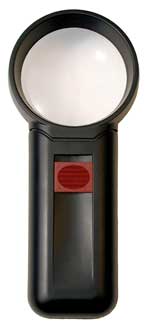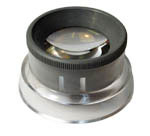
|
|
Magnifying Devices
Optical devices are of two kinds - near and distance. Near devices are designed for magnifying close objects and print. Distance devices are for magnifying things in the distance (from about 3 metres to far away).
Check that each person has been examined to see if spectacles are needed to correct or improve vision before recommending low vision devices.
It is necessary to find out what people are unable to see and what they want to be able to see better. It might be a very specific task such as reading labels on food packets. The nature of the task will also affect the type of low vision device which is suitable. Before selecting a low vision device, consider:
- the size of objects to be viewed
- the possible viewing distance from the object
- the length of time needed for the activity
- whether one or both hands are needed for the activity.
Some people use both near and distance devices, others use only one type.
Optical devices for near tasks
Magnifiers for close tasks are designed to be either held in the hand (handheld magnifier), to be placed on a book or over a small object (stand magnifier) or mounted in spectacle frames. With magnifiers for near tasks, objects or print look larger and detail can be seen. A stand magnifier is a strong lens which is mounted in a plastic stand. A stand magnifier is usually easier than a hand held magnifier for a child to use. It can be moved along while still resting on a page of a book. With spectacle magnifiers, both hands are free to work on tasks.
Magnifiers for near tasks can be used for:
- reading a book or a newspaper
- reading labels, signs or prices in shops
- using tools, for example measuring
- threading a needle
- identifying money
- inspecting objects such as plants or insects
For reading, the magnifier has to be moved along each line of print, sometimes only showing a word or part of a word at a time. More words will be seen if the eye is held close to the magnifier. Reading is very slow at first. It is difficult to learn to use the magnifier properly - a lot of practice is needed.
Optical devices for distance tasks
Magnifiers for distance are like small telescopes. They improve the ability to see distant objects or people. Objects appear to be closer and it is hard to judge distances properly. It is best not to use telescopes while walking around.
Training to use optical devices
Encouragement and training are needed for people to use low vision devices well.
The field of view or amount able to be seen through the magnifier or telescope is small. It takes practice to be able to find objects and then follow them or scan to find other objects.
For distance tasks it is best to look in the general direction of an object without the device and then point or place the device in that direction to locate objects. It is easier to scan along horizontal objects such as roads or fences and up and down vertical objects such as trees or walls.
Training in the use of all magnifying devices is vital!
Magnifying glasses
Useful for when you need both hands free for the task e.g. School age children/adults who need to read and write a lot.
Up to 20 Dioptres can be prescribed.
Always consider if non-optical devices might help instead of or with magnification! For example, a writing stand is useful for relieving posture problems.
Do not just give out magnifying glasses, if there is no one to train the person in its use. A person will often reject the device, because they do not know how to see better with it.
1. Uses:
- for reading any material
- writing
- looking at objects from close range
2. Advantages:
- range of magnification
- both hands free
- readily available- e.g."cataract" glasses can be used as reading glasses
- once used efficiently, can be used for long periods
3. Disadvantages:
- exact reading distance important
- Short reading distance with high powered lenses
- more fragile than magnifiers (scratching, breaking)
- good lighting needed at close distance
- often a reading stand is beneficial to bring material close
Hand Magnifiers
1. Uses:
- reading signs, labels, prices, books
- identifying money
- inspecting objects such as plants or insects
- handwriting
2. Advantages:
- easy to carry
- available from low to high power
- cheap to make or buy
- can be used in any position or angle
- allows light onto print or objects
3. Disadvantages:
- difficult to keep appropriate distance
- one hand occupied
- difficult to hold steady
Stand Magnifiers
1. Uses
- Reading from a book or newspaper
- Looking at a picture or diagram
2. Advantages
- Has a fixed distance for ease of movement
- Easy to use
- Available from low to high power magnification
- Allows light onto print if legs thin and tapered or clear
3. Disadvantages
- Keeps one hand occupied
- Not useful for activities like writing
- Poor posture (bending above lens)
- Causes fatigue
Telescopes
Telescopes can be used for looking at distant objects and activities such as:
- signs
- finding and recognising people or animals
- reading from a blackboard in school
- finding an entrance to a building
- watching games.
1. Uses
- Reading from a blackboard from a distance >2 m
- Looking at objects you cannot get close to, e.g. top of a tree, animals
2. Advantages
- Makes distant objects appear closer
- Can be used in a classroom for blackboard reading or outdoors
3. Disadvantages
- Requires very good contrast
- Not easy to copy what you have seen, takes time to:
- Find text on blackboard and read
- Write notes down, possibly using other low vision device
- Expensive to make
- Not easy to use, requires extensive training
What are the 3 types of magnifiers for near vision?
Name an optical device for viewing close objects. List an advantage and disadvantage of this device
Name an optical device for viewing far objects. List an advantage and disadvantage of this device
|
|
| Visual Communication Unit |




